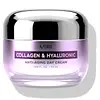What's inside
What's inside
 Key Ingredients
Key Ingredients

 Benefits
Benefits

 Concerns
Concerns

 Ingredients Side-by-side
Ingredients Side-by-side

Water
Skin ConditioningGlycerin
HumectantEthylhexyl Palmitate
EmollientCetearyl Alcohol
EmollientPropylene Glycol
HumectantCetearyl Glucoside
EmulsifyingSoluble Collagen
HumectantSodium Hyaluronate
HumectantButyrospermum Parkii Oil
EmollientBetaine
HumectantPanthenol
Skin ConditioningSqualene
EmollientOlea Europaea Fruit Oil
MaskingArgania Spinosa Kernel Oil
EmollientCitrus Paradisi Seed Extract
MaskingBeta-Glucan
Skin ConditioningPortulaca Oleracea Extract
Skin ConditioningAloe Barbadensis Leaf Juice
Skin ConditioningPropanediol
SolventTocopheryl Acetate
AntioxidantXanthan Gum
EmulsifyingHydroxyethyl Acrylate/Sodium Acryloyldimethyl Taurate Copolymer
Emulsion StabilisingCarbomer
Emulsion StabilisingDimethicone
EmollientTriethanolamine
Buffering1,2-Hexanediol
Skin ConditioningEthylhexylglycerin
Skin ConditioningPhenoxyethanol
PreservativeParfum
MaskingLimonene
PerfumingAlpha-Isomethyl Ionone
PerfumingWater, Glycerin, Ethylhexyl Palmitate, Cetearyl Alcohol, Propylene Glycol, Cetearyl Glucoside, Soluble Collagen, Sodium Hyaluronate, Butyrospermum Parkii Oil, Betaine, Panthenol, Squalene, Olea Europaea Fruit Oil, Argania Spinosa Kernel Oil, Citrus Paradisi Seed Extract, Beta-Glucan, Portulaca Oleracea Extract, Aloe Barbadensis Leaf Juice, Propanediol, Tocopheryl Acetate, Xanthan Gum, Hydroxyethyl Acrylate/Sodium Acryloyldimethyl Taurate Copolymer, Carbomer, Dimethicone, Triethanolamine, 1,2-Hexanediol, Ethylhexylglycerin, Phenoxyethanol, Parfum, Limonene, Alpha-Isomethyl Ionone
Diisostearyl Malate
EmollientEthylhexyl Palmitate
EmollientButyrospermum Parkii Butter
Skin ConditioningMicrocrystalline Wax
Emulsion StabilisingRosa Canina Fruit Oil 5%
EmollientDipentaerythrityl Hexahydroxystearate
EmulsifyingHelianthus Annuus Seed Oil
EmollientEuphorbia Cerifera Cera
AstringentTocopheryl Acetate 0.5%
AntioxidantSimmondsia Chinensis Seed Oil
EmollientGlyceryl Caprylate
EmollientVitis Vinifera Seed Oil
EmollientPrunus Amygdalus Dulcis Oil
Skin ConditioningParfum
MaskingSqualane
EmollientHydrogenated Polyisobutene
EmollientOlea Europaea Fruit Oil
MaskingVegetable Oil
Skin ConditioningOlea Europaea Husk Oil
Skin ConditioningPolyglyceryl-2 Triisostearate
EmulsifyingPolysorbate 20
EmulsifyingCI 45380
Cosmetic ColorantLinoleic Acid
CleansingTocopherol 0.001%
AntioxidantOleic Acid
EmollientPalmitic Acid
EmollientStearic Acid
CleansingAnemarrhena Asphodeloides Root Extract
Skin ConditioningLinolenic Acid
CleansingBenzyl Alcohol
PerfumingLinalool
PerfumingDiisostearyl Malate, Ethylhexyl Palmitate, Butyrospermum Parkii Butter, Microcrystalline Wax, Rosa Canina Fruit Oil 5%, Dipentaerythrityl Hexahydroxystearate, Helianthus Annuus Seed Oil, Euphorbia Cerifera Cera, Tocopheryl Acetate 0.5%, Simmondsia Chinensis Seed Oil, Glyceryl Caprylate, Vitis Vinifera Seed Oil, Prunus Amygdalus Dulcis Oil, Parfum, Squalane, Hydrogenated Polyisobutene, Olea Europaea Fruit Oil, Vegetable Oil, Olea Europaea Husk Oil, Polyglyceryl-2 Triisostearate, Polysorbate 20, CI 45380, Linoleic Acid, Tocopherol 0.001%, Oleic Acid, Palmitic Acid, Stearic Acid, Anemarrhena Asphodeloides Root Extract, Linolenic Acid, Benzyl Alcohol, Linalool
Ingredients Explained
These ingredients are found in both products.
Ingredients higher up in an ingredient list are typically present in a larger amount.
Ethylhexyl Palmitate, also known as octyl palmitate, is created from 2-ethylhexyl alcohol and palmitic acid. It is a fatty acid ester.
The fatty acid content of Ethylhexyl Palmitate makes it an emollient. Emollients help soften and hydrate your skin by trapping moisture within.
Ethylhexyl Palmitate is also used to help improve the texture of cosmetics. It helps other ingredient dissolve in products and help disperse ingredients more evenly.
You'll likely find this ingredient in sunscreen, as it is often used to mix UV-blocking ingredients such as avobenzone and ethylhexyl triazone.
It can also help stabilize the fragrances in a product as a fragrance fixative.
Ethylhexyl Palmitate can be used to substitute mineral oil.
Due to its high fatty acid content, it may not be fungal-acne safe.
Learn more about Ethylhexyl PalmitateOlea Europaea Fruit Oil is the fixed oil obtained from the ripe fruit of the Olive. In other words - olive oil.
The primary contents of olive oil are glycerides of the fatty acids linoleic, oleic and palmitic.
Olive oil also contains antioxidants such as Vitamin E. Antioxidants may help reduce signs of aging by fighting unstable free-radical molecules. It also contains Vitamins A (retinol), D, and K.
The squalene in olive oil makes it a great emollient. Emollients help soothe and soften your skin by trapping moisture in. This makes olive oil a great skin moisturizer.
Studies show olive oil to have antibacterial and antifungal properties in low concentrations. Another study found olive oil irritated sensitive oily skin. We always recommend speaking with a professional about using this ingredient in your routine.
Due to the fatty acid content, this ingredient may not be fungal-acne safe.
Learn more about Olea Europaea Fruit OilParfum is a catch-all term for an ingredient or more that is used to give a scent to products.
Also called "fragrance", this ingredient can be a blend of hundreds of chemicals or plant oils. This means every product with "fragrance" or "parfum" in the ingredients list is a different mixture.
For instance, Habanolide is a proprietary trade name for a specific aroma chemical. When used as a fragrance ingredient in cosmetics, most aroma chemicals fall under the broad labeling category of “FRAGRANCE” or “PARFUM” according to EU and US regulations.
The term 'parfum' or 'fragrance' is not regulated in many countries. In many cases, it is up to the brand to define this term.
For instance, many brands choose to label themselves as "fragrance-free" because they are not using synthetic fragrances. However, their products may still contain ingredients such as essential oils that are considered a fragrance by INCI standards.
One example is Calendula flower extract. Calendula is an essential oil that still imparts a scent or 'fragrance'.
Depending on the blend, the ingredients in the mixture can cause allergies and sensitivities on the skin. Some ingredients that are known EU allergens include linalool and citronellol.
Parfum can also be used to mask or cover an unpleasant scent.
The bottom line is: not all fragrances/parfum/ingredients are created equally. If you are worried about fragrances, we recommend taking a closer look at an ingredient. And of course, we always recommend speaking with a professional.
Learn more about ParfumTocopheryl Acetate is AKA Vitamin E. It is an antioxidant and protects your skin from free radicals. Free radicals damage the skin by breaking down collagen.
One study found using Tocopheryl Acetate with Vitamin C decreased the number of sunburned cells.
Tocopheryl Acetate is commonly found in both skincare and dietary supplements.
Learn more about Tocopheryl Acetate